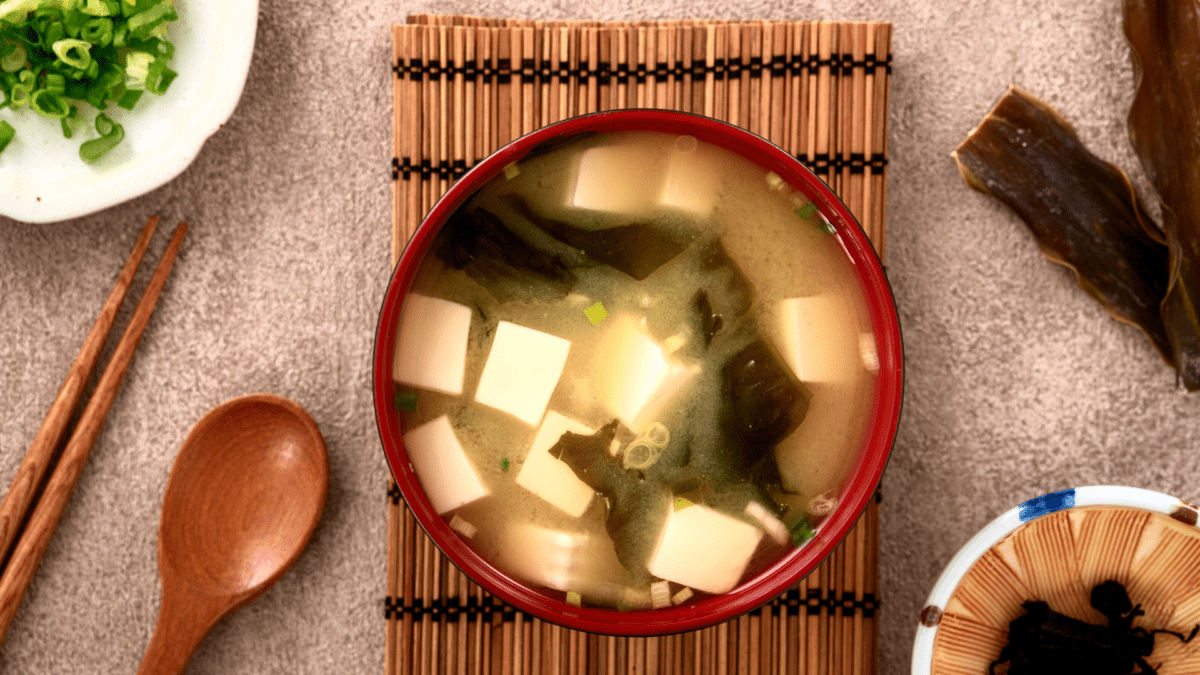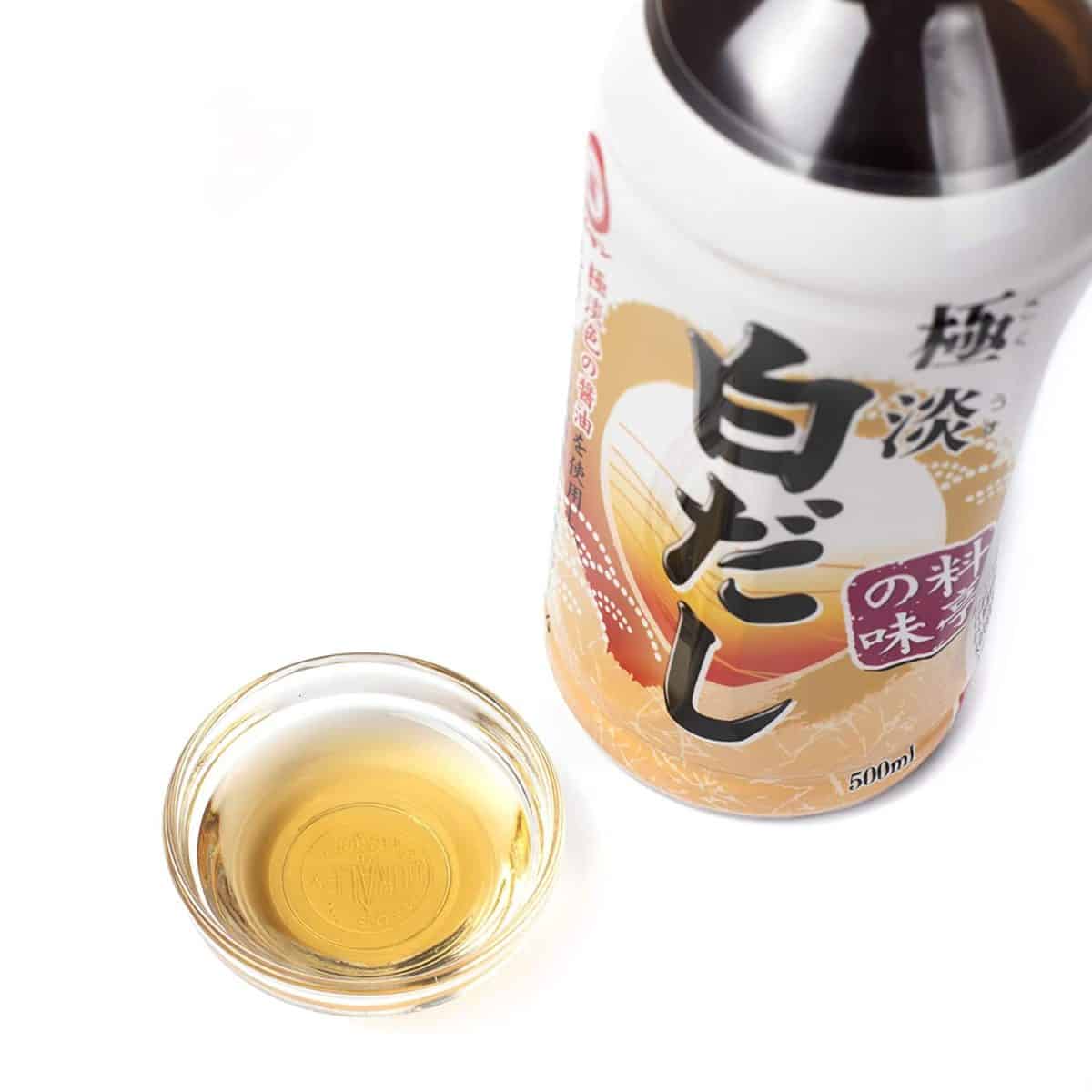Shirodashi: when and how to use white dashi stock
Japanese cuisine is known for its combination of sweet and salty flavors, as well as its use of fresh ingredients.
The flavors come from a variety of umami condiments, seasonings, and stocks.
Shiro dashi is one of the most refined types of dashi stock.
It’s hard to find an authentic Japanese restaurant that doesn’t serve umami-packed dashi soup.

The clear soup is used as a base for many dishes, including noodle soups, vegetable dishes, and hot pots.
But shiro dashi is usually served at fine dining restaurants as a part of kaiseki cuisine because of its delicious taste.
Shiro dashi is a Japanese soup base made with a light-colored soy sauce (usukuchi soy sauce). Like regular dashi soup stock, it’s made with bonito flakes, kombu (kelp), mirin, and salt but the difference is the addition of golden soy sauce, also known as white soy sauce.

Check out our new cookbook
Bitemybun's family recipes with complete meal planner and recipe guide.
Try it out for free with Kindle Unlimited:
Read for freeIn this post we'll cover:
What is shiro dashi?
“Shiro” is the Japanese word for “white” and dashi is the traditional Japanese soup stock.
Thus, shiro dashi literally translates to “white soup stock.”
This type of dashi is used mainly in clear soups such as miso soup, as well as in noodle dishes such as udon and soba.
But it can practically be used for any savory simmered dish.
This stock is best known for its savory and “umami” flavor.
Japanese cooking is known for its use of dashi soup stock.
Dashi is a clear broth made with just a few simple ingredients: kombu (dried kelp), bonito flakes (dried and smoked skipjack tuna), soy sauce, and water.
It can also be vegan when the dried bonito flakes are replaced with shiitake mushrooms.
Shiro dashi is considered to be a concentrated dashi soup base and it is diluted before use.
The Shiro dashi is unique compared to dashi powder and other dashi broth because it’s made with light-colored soy sauce.
This lighter soy is known as usukuchi soy sauce or usukuchi shoyu.
Therefore, the broth won’t have the dark color of regular dashi which is made with dark soy sauce.
What are the ingredients in shirodashi?
Shirodashi is one of those condiments that can alter the flavor of Japanese foods. But each region varies the ingredients slightly, although they largely remain the same everywhere.
- White soy sauce (also known as light-colored soy sauce)
- Sugar
- Mirin
- Salt
- Kombu extract or kombu seaweed
- Bonito flakes
Depending on the region, some might also add ginger, sake, and/or dried shiitake mushrooms.
How to make shirodashi?
Making shiro dashi is incredibly easy.
The only ingredients you need are water, kombu (dried kelp), sugar, light soy sauce, mirin, salt, and bonito flakes.
You can find all of these ingredients at your local Japanese grocery store.
First, soak the kombu in water for 30 minutes. Then, remove the kombu and add sugar, light soy sauce, mirin, and salt to the water.
Place the mixture over medium heat and simmer for 5 minutes. Then, add the bonito flakes and remove from heat.
Boil bonito flakes for 3 minutes and then strain.
Your shiro dashi is now ready to use!
How to use shirodashi?
It should be diluted suitably according to the dish, just like with concentrated mentsuyu.
When preparing soups and stews in the Japanese style, Japanese cooks frequently utilize shirodashi. It doesn’t really change the color of the dish.
Shirodashi is best used:
- as a noodle soup base
- osuimono clear broth
- in simmered dishes
- for udon noodles and soba noodle dishes
- for shirodashi soup
- in miso soup
- hotpot
- to give flavor to boiled vegetables
- making pasta sauce
- gives any Japanese dish a salty taste
- for Japanese style mixed rice
- marinade
- Tamagoyaki (Japanese rolled omelet)
- Chawanmushi (egg custard)
However, it can also be frequently used for other foods, including Chinese food like ankake chahan, a fried rice recipe with starchy sauce, stir-fried pepper steak, paitan chicken soup.
Professional Japanese chefs, including those in high-end restaurants, use it to enhance the flavor of their dishes.
In addition to using it in soups, stews, and noodle dishes, shirodashi can be used as a dipping sauce for tempura, sashimi, and other Japanese dishes.
Shirodashi can also be used as a marinade for meats and vegetables.
In recent years, shirodashi bottles (like this shiro dashi concentrate from Marukin) have been widely accessible at grocery shops, thus it is also utilized in regular households.

What are the benefits of shirodashi?
Shirodashi is a healthy alternative to using MSG or other chemicals to enhance the flavor of your food.
It is made with all-natural ingredients and is very low in calories.
Shirodashi is also a good source of umami, which is the secret flavoring ingredient for many Japanese foods.
It’s important to be careful of quantity when using shiro dashi because it is quite salty, thus high in sodium.
Here are some other benefits of using shiro dashi when cooking:
- Due to its many ingredients, shiro dashi is a perfectly prepared condiment, negating the need for additional seasoning preparation.
- Shiro dashi is a lighter soy sauce than regular soy sauces, so you won’t have to worry about your dish getting brown.
- In some situations, bland foods are less likely to whet your appetite. For example, a tamagoyaki omelet that is dark in color may appear less appetizing than one that is unseasoned and yellow. As a result, shiro dashi might be better for dish decoration than mentsuyu and soy sauce.
- Umami’s richness can improve the overall taste of your traditional Japanese dishes as well as Western ones.
What is the difference between shirodashi and dashi?
Shiro dashi is made with light-colored soy sauce, whereas the regular dashi soup stock is made with dark soy sauce.
Other than that, the ingredients used in both are largely the same.
The main difference is in the flavor and color of the soup base. Shiro dashi is known for its savory and “umami” flavor, while regular dashi has a more intense flavor.
What is the difference between shiro and dashi miso?
Shiro miso is a type of white miso, while dashi miso is made with dashi soup stock.
The main difference between the two is in the flavor. Shiro miso is sweeter and has a milder flavor, while dashi miso is saltier and has a more intense flavor.
The bottom line is that dashi soup base is used to give flavor to various dishes, while dashi miso paste is used to make miso soup, and it’s a thick paste-like condiment.
What is the difference between shiro dashi and hondashi?
Hondashi is a specific type of dashi granules by the brand Ajinomoto.
Hondashi is made with bonito fish flakes and it’s used to give flavor to various dishes, just like shiro dashi.
The powder is dissolved in hot water. The main difference is that shiro dashi uses light-colored soy sauce, while hondashi uses dark soy sauce.
So, shiro dashi contains Shiro shoyu light soy sauce as one of its ingredients, while hondashi does not.
Shiro dashi also has a greater variety of other ingredients such as kombu, mirin, etc.
These additional ingredients give shiro dashi a more intense taste.
Learn more about the amazing seaweed variety that is kombu here
FAQs
Is shiro dashi gluten-free?
Usually, shiro dashi is gluten-free since it’s made with soy sauce. However, it’s always best to check the ingredients list on the bottle to be sure.
Is shiro dashi vegan?
No, shiro dashi contains bonito flakes an ingredient derived from fish. However, it can be made vegan by replacing bonito flakes with shiitake mushrooms.
What is the shelf life of shirodashi?
When stored in a cool and dry place, an unopened bottle of shirodashi can last up to 2 years. Once opened, it should be used within 6 months.
How to store shirodashi?
It’s best to store shirodashi in a cool and dry place, such as the pantry. Once opened, it should be stored in the fridge. This ensures it doesn’t spoil.
What is the best brand of shiro dashi?
Mizkan shiro dashi in liquid form is one of the best authentic-flavored Japanese seasonings.
It is made with high-quality ingredients such as white soy sauce, salt, and mirin.
Kikkoman is another popular brand of shiro dashi and it’s more accessible price-wise. You might know Kikkoman from the soy sauce, but the brand offers many other tasty sauces.
You can also get shiro dashi powder in the form of sachets from the brand Yamaki Udon.
Conclusion
Those looking for a versatile dashi base will appreciate the refined taste of shirodashi.
It’s perfect for those who appreciate the “umami” taste in their dishes. It also adds salty taste to any type of food, even fried chicken!
Professional chefs and home cooks love to use this type of dashi compared to the regular kombu dashi because it doesn’t change the food’s color.
Hence why it’s one of the best-kept seasonings in Japan.
Next, learn about 7 easy ways to make dashi without kombu and still get the perfect umami!
Check out our new cookbook
Bitemybun's family recipes with complete meal planner and recipe guide.
Try it out for free with Kindle Unlimited:
Read for freeJoost Nusselder, the founder of Bite My Bun is a content marketer, dad and loves trying out new food with Japanese food at the heart of his passion, and together with his team he's been creating in-depth blog articles since 2016 to help loyal readers with recipes and cooking tips.
